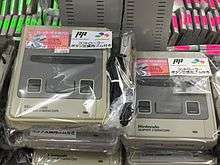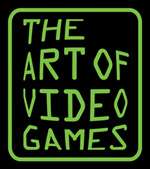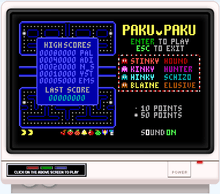Retrogaming
Retrogaming, also known as classic gaming and old school gaming, is the playing or collecting of older personal computer, console, and/or arcade video games in contemporary times. Usually, retrogaming is based upon systems that are obsolete or discontinued. It is typically put into practice for the purpose of nostalgia, preservation or the need to achieve authenticity.

Retrogaming has three main activities; vintage retrogaming, retrogaming emulation, and ported retrogaming. Vintage retrogaming includes games that are played on the original hardware. Emulation involves newer systems simulating old gaming systems, while ported retrogaming allows games to be played on modern hardware via ports or compilations. Additionally, the term could apply to a newer game, but with features similar to those of older games, such as a "retro RPG" which features turn-based combat and an isometric camera perspective.
Participants in the hobby are sometimes known as retrogamers in the United Kingdom, while the terms "classic gamers" or "old school gamers" are more prevalent in the United States. Similarly, the games are known as retrogames, classic games, or old school games.[1]
Retrogaming has existed since the early years of the video game industry, but was popularized with the popularity of the Internet and emulation technology.[2] It is argued that the main reasons players are drawn to retrogames are nostalgia for different eras,[3] the idea that older games are more innovative and original,[3] and the simplicity of the games that requires less hours of gameplay.
Retrogaming and retrocomputing have been described as preservation activity and as aspects of the remix culture.[4]
Games
The games and systems can be anything not in the current generation.[5] Retro games can include video games as well as personal computer games for retrocomputing platforms. Arcade games are also popular, and were frequently attributed to individual programmers. The distinction between what is considered retro and modern is heavily debated, but it usually coincides with either the shift from 2D to 3D games (making the fourth gen the last retro generation, and the fifth being the first modern),[6] the turn of the millennium and the increase in online gaming (making the fifth gen the last retro generation, and the sixth being the first modern), or the switch from RCA to HDMI cables for video and sound transfer (making the sixth gen the last retro generation, and the seventh being the first modern). Some games are played on the original hardware; others are played through emulation. Some retro games can still be played online using just the internet browser via DOS emulation.[7] In some cases, entirely new versions of the games are designed, or remade. As well as playing games, a subculture of retrogaming has grown up around the music in retro games.
Reasons
Reasons that people use concerning playing video games on original hardware include:
Correct aspect ratio and/or image quality
Without excessive modification, modern displays cannot present retro games properly, typically leading to distorted picture and sound quality. This is why many gamers resort to purchasing older televisions for the hobby. Other reasons may include that some games take advantage of the image stretching to create wider and more detailed displays, such as Chrono Trigger or Super Mario All Stars.
Sound quality
Prior to digital sound, older game systems would replicate different tones and notes based on a specific selection of chips. Newer displays may have trouble replicating these sounds exactly.
Game availability and console rarity
The ability to play certain games on their original hardware may vary depending on the console and the applicable region. Variations due to region are also known as "region locking".
Retrogaming methods
In the wake of increasing nostalgia and the success of retro-compilations in the fifth, sixth, and seventh generations of consoles, retrogaming has become a motif in modern games, as well. Modern retrogames impose limitations on color palette, resolution, and memory well below the actual limits of the hardware in order to mimic the look of older hardware. These may be based on a general concept of retro, as with Cave Story, or an attempt to imitate a specific piece of hardware, as with La Mulana and its MSX color palette.
This concept, known as Deliberate Retro[8] and NosCon,[9] began to gain traction thanks in part to the independent gaming scene,[10] where the short development time was attractive and commercial viability was not a concern. Major publishers have embraced modern retrogaming with releases such as Mega Man 9, an attempt to mimic NES hardware; Retro Game Challenge, a compilation of new games on faux-NES hardware; and Sega's Fantasy Zone II remake, which uses emulated System 16 hardware running on PlayStation 2 to create a 16-bit reimagining of the 8-bit original.
Vintage retrogaming

Vintage retrogaming involves players collecting the original hardware, cartridges, and discs the video games were originally released on.[12] The hardware collected includes arcade systems, old home consoles, and their cartridges and discs. Some of these collectables can be fairly expensive and hard to find, limiting the access to these old games.[13][14] The vast majority, however, sell for much less than their retail price.[15]
The popularity of vintage retrogaming has led to the circulation of pirated copies of retro games, which are generally considered to lack the collector value of the original cartridges and discs.[15]
Retrogaming emulation
Retrogaming emulation involves older gaming systems being emulated on new hardware. It bypasses the need to collect old consoles and original games. ROMs, read only memory files, are taken directly from the original cartridge or disc from third parties. They are then typically put online through file sharing sites and played via emulators on modern hardware.[12] They are also often sold as re-releases, typically in compilations containing multiple games running on emulation software.[16] Since emulation is a more accessible way to take part in retrogaming, it helped to popularize and expand on the hobby.[2]
Ported retrogaming
Ported retrogaming involves old games being played on new systems, just as emulation. It differs from emulation because the games are rewritten for the new system and don't use the original ROM files.[12] Ported games are available through official collections, console-based downloads, and plug and play systems.[2] Ported retrogaming is comparatively rare, since emulation is a much easier and more accurate method of running retro games on modern hardware.
Remakes
Modern retrogaming may sometimes be more broadly applied to games that feature retro-style designs and reimaginings with more modern graphics. These enhanced remakes include Pac-Man: Championship Edition, Space Invaders Extreme, Super Mega Worm, 3D Dot Game Heroes. Some are based directly upon the enhanced emulation of original games, as with Nintendo's NES Remix.
When remakes are created by an individual or a group of enthusiasts without commercial motivation, such games sometimes are also called fangames. These are often motivated by the phenomenon of abandonware, which is the discontinuation of sales and support by the original producers. Examples of fan-made remakes are King's Quest I: Quest for the Crown, King's Quest II: Romancing the Stones, and Freeciv.
The nostalgia-based revival of older game styles has also been accompanied by the development of the modern chiptune genre of game music. Chiptunes are characterized by severe limitations of sound imposed by the author's self-restriction to using only the original sound chips from 8-bit or 16-bit games. These compositions are featured in many retro-style modern games and are popular in the demoscene.
Re-releases
With the new possibility of the digital distribution in mid-2000 the commercial distribution of old classical game titles became feasible again as deployment and storage costs dropped significantly:
... we can put something up on Steam [a digital distributor], deliver it to people all around the world, make changes. We can take more interesting risks.... Retail doesn't know how to deal with those games. On Steam there's no shelf-space restriction. It's great because they're a bunch of old, orphaned games
A digital distributor specialized in bringing old games out of abandonware is GOG.com (formerly called Good Old Games) who started 2008 to search for copyright holders of classic games to re-release them legally and DRM-free.[19]
Notable online platforms for classic video game re-releases include Nintendo's Virtual Console and Sony's PlayStation Network.
Mobile application developers have been purchasing the rights and licensing to re-release vintage arcade games on iOS and Android operating systems. Some publishers are creating spinoffs to their classic games, keeping the core gameplay while adding new features, levels, and styles of play.
Plug-and-play systems
Plug-and-play systems have been released or licensed by companies such as Atari, Sega, and Nintendo. These systems include stand-alone game libraries and plug directly into the user's television.[12]
Retrogaming community

The video game industry has an active audience, including the retrogaming sector. The retrogaming community has both online and physical spaces where retrogames are discussed, collected, and played.[2]
Online retrogaming community
There are several websites and online forums devoted to both retrogaming and video games in general. The content on these online platforms typically includes reviews of older games, interviews with developers, fan-made content, game walkthroughs, and message boards for discussions.[2] Many gameplay videos posted online feature attempts at breaking speedrun or high score records.
Fighting game community
The competitive Fighting game community traces its legacy from old-school arcades.[20] Some fighting games have continued to receive arcade releases after the end of the arcade era.[21] Face-to-face competition of Super Street Fighter II Turbo has been featured in the Evolution Championship Series.[22]
Exhibitions
There are several events that retrogamers can take part in. Exhibits typically include vendors, retrogames available to play, tournaments, costumes, and live music, such as the Vancouver Retro Gaming Expo, run by Phase 3 events. This event has been occurring annually since March 17, 2012.[23]
Retrogaming in museums
Retrogaming is recognized by museums worldwide. For example, the RetroGames arcade museum of Karlsruhe, Germany was founded in 2002[24][25] and the Computerspielemuseum Berlin was founded in 1997. Some classical art museums bear a video gaming retrospective, as with 2012's Smithsonian American Art Museum exhibition titled The Art of Video Games[26] or as part of the Museum of Modern Art "Applied Design" exhibition in 2013.[27] Starting in 2015, The Strong National Museum of Play adds games annually to the World Video Game Hall of Fame. In 2016, the first museum dedicated solely to the history of the videogame industry, The National Videogame Museum, was opened in Frisco, Texas.
Legal issues surrounding retrogaming
Though many abandonware titles are available for free download on third-party websites, the duration of copyright on creative works in most countries is far longer than the era of home computing.
Emulators are typically created by third parties, and the software they run is often taken directly from the original games and put online for free download.[12] While it is completely legal for anyone to create an emulator for any hardware, unauthorized distribution of the code for a retro game is an infringement of the game's copyright.[28] Some companies have made public statements regarding the issues, such as Nintendo, stating that "the introduction of emulators created to play illegally copied Nintendo software represents the greatest threat to date in the intellectual property rights of video game developers".[29] However, video game developers and publishers typically turn a blind eye to emulation.[12] One reason for this is that at any given time, most of the games illegally distributed for emulation are not presently being sold by the company which owns the game, and so the damages the company would collect in the event of a successful lawsuit would most likely be negligible.[28]
See also
References
- GOING RETRO: 14 Old School Games You Can Play On Your iPhone Right Now
- Heineman, David S. (2014-01-22). "Public Memory and Gamer Identity: Retrogaming as Nostalgia". Journal of Games Criticism. Retrieved 2016-02-22.
- "Revival of the Fittest". Next Generation. No. 28. Imagine Media. April 1997. pp. 36–45.
- Yuri Takhteyev, Quinn DuPont (2013). "Retrocomputing as Preservation and Remix" (PDF). iConference 2013 Proceedings (pp. 422–432). doi:10.9776/13230. University of Toronto. Retrieved 2016-03-26.
This paper looks at the world of retrocomputing, a constellation of largely non-professional practices involving old computing technology. Retrocomputing includes many activities that can be seen as constituting "preservation." At the same time, it is often transformative, producing assemblages that "remix" fragments from the past with newer elements or joining together historic components that were never combined before. While such "remix" may seem to undermine preservation, it allows for fragments of computing history to be reintegrated into a living, ongoing practice, contributing to preservation in a broader sense. The seemingly unorganized nature of retrocomputing assemblages also provides space for alternative "situated knowledges" and histories of computing, which can sometimes be quite sophisticated. Recognizing such alternative epistemologies paves the way for alternative approaches to preservation.
CS1 maint: uses authors parameter (link) - Scott, Jennifer (2017-06-28). "Retro gaming: Why players are returning to the classics". BBC. Archived from the original on 2017-07-26. Retrieved 2017-07-26.
- "Retro-gaming, what is it? [Le retro-gaming, qu'est-ce-que c'est?]". grospixels.com. Retrieved 2017-11-03.
- "10 best retro games you can play online". Mwave.com.au. Retrieved 2014-06-18.
- "Deliberately Retro". giantbomb.com. Retrieved 2017-05-04.
- "NosCon". giantbomb.com. Retrieved 2017-11-03.
- "9 indie games shamelessly inspired by retro ancestors". gamesradar.com. Retrieved 2017-11-03.
- http://www.eurogamer.net/articles/2012-09-12-crippled-by-nostalgia-the-fraud-of-retro-gaming
- "What is Retrogaming?". wiseGEEK. Retrieved 2016-02-22.
- http://igcritic.com/what-happened-to-classic-video-game-packaging/
- http://www.racketboy.com/retro/nintendo/snes/the-rarest-and-most-valuable-super-nintendo-snes-games
- "The Real Thing". Next Generation. No. 28. Imagine Media. April 1997. pp. 44–45.
- "Classic Game Collections". Next Generation. No. 28. Imagine Media. April 1997. pp. 40–41.
- Knight, Jason. "Paku Paku – A game for early PC/MS-DOS Computers". deathshadow.com. Retrieved 2013-01-16.
- Walker, John (2007-11-22). "RPS Exclusive: Gabe Newell Interview". Rock, Paper, Shotgun. Retrieved 2013-06-28.
The worst days [for game development] were the cartridge days for the NES. It was a huge risk – you had all this money tied up in silicon in a warehouse somewhere, and so you'd be conservative in the decisions you felt you could make, very conservative in the IPs you signed, your art direction would not change, and so on. Now it's the opposite extreme: we can put something up on Steam, deliver it to people all around the world, make changes. We can take more interesting risks.... Retail doesn't know how to deal with those games. On Steam [a digital distributor] there's no shelf-space restriction. It's great because they're a bunch of old, orphaned games.
- Caron, Frank (2008-09-09). "First look: GOG revives classic PC games for download age". Ars Technica. Retrieved 2012-12-27.
... [Good Old Games] focuses on bringing old, time-tested games into the downloadable era with low prices and no DRM.
- Bowman, Mitch. "Why the fighting game community is color blind".
- "A Brief History of 2D Fighting Games".
- Walker, Ian. "Evo 2015 Super Street Fighter II Turbo Side Tournaments Unveiled, Registration Now Live".
- VGE. "Vancouver Retro Gaming Expo". www.vancouvergamingexpo.com. Retrieved 2016-02-22.
- RetroGames e.V. (german)
- Schmitz, Peter (2002-07-19). "Erster eingetragener Verein für Computer- und Konsolenspiele-Oldies eröffnet" (in German). Heise.de. Retrieved 2012-06-01.
- Snider, Mike (2012-03-13). "Are video games art? Draw your own conclusions". USA Today. Gannett. Retrieved 2012-06-02.
- Antonelli, Paola (2012-11-29). "Video Games: 14 in the Collection, for Starters". Inside / Out. A MoMA/MoMA PS1 Blog. Museum of Modern Art. Retrieved 2012-11-29.
- "Emulations". Next Generation. No. 28. Imagine Media. April 1997. pp. 42–43.
- "| Nintendo – Corporate Information | Legal Information (Copyrights, Emulators, ROMs, etc.)". www.nintendo.com. Retrieved 2016-02-22.
